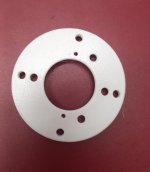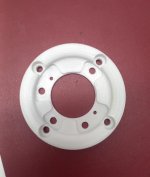I started to make the Tritonia-M wide, but struggle to read the width of the device from the ath output. How do I find out how large the device is?
Yeah, I need to return this output to the published ath version. For some reason I removed it at some point and forgot about it...
What it would tell us?Perhaps do a recording? Like use a pair of horns with the same drivers, EQed flat. Play a sweep in horn A while horn B is connected to the mic input of a sound card... ?
- I think this would need an anechoic chamber to assess the actual effect on perception. To record the picked-up signal and then mix it with the original signal for testing. Sounds a) like a lot of work and b) I don't have the chamber 🙂 (If it could be simulated like this at all.)
Well, maybe headphones would suffice.

Last edited:
"I don't have a clue how significant it is. During playback in a room, there will be a lot of pretty loud sounds reaching the diaphragm, which are all correlated to the signal"
If one would like to know the impact of the suspected effect in a stereo setup - the test should be made in that setup, no chambers..., the effort should only be to hook in the speaker of one channel to an ADC and and perform a measure. Perhaps a second sweep with a mic in the same position as the "speaker-mic" to asess what the sonic stimuli was at the speaker (mic!) entrance.
A fun test!? And perhaps telling.
//
If one would like to know the impact of the suspected effect in a stereo setup - the test should be made in that setup, no chambers..., the effort should only be to hook in the speaker of one channel to an ADC and and perform a measure. Perhaps a second sweep with a mic in the same position as the "speaker-mic" to asess what the sonic stimuli was at the speaker (mic!) entrance.
A fun test!? And perhaps telling.
//
But this way you're not finding out the impact (on perception), only proving that some signal reaches the diaphragm. But we already know that.
To find out the impact, if any, you need to do a direct listening test with and without the "noise" signal.
To find out the impact, if any, you need to do a direct listening test with and without the "noise" signal.
Last edited:
Perhaps. We could all conjecture endlessly. But this is not how to know anything and I won't do the experiments, so to myself I leave the conclusion open...
What if this is the mysterious horn honk? 🙂 Do we have a conclusive answer for that?
What if this is the mysterious horn honk? 🙂 Do we have a conclusive answer for that?
That would be helpful. The workaround of ocassionally falling back to an older ath version is somewhat tedious.Yeah, I need to return this output to the published ath version. For some reason I removed it at some point and forgot about it...
OK. Have you listened to the "addition"? If not, that could give en impression perhaps...But we already know that.
//
And now I need a break from designing horns...
But we still need matching midrange and mid bass horns!
Here's an anecdote from Dave Rat of Rat Sound that suggests that it can be a problem. To what extent it might affect systems at levels typical of domestic use I don't know, but it does seem terribly unlikely that it'd be very significant.if that would cause any issue, it would have shown up in the last century or so. Especially PA systems with high SPL would then be affected but it is not as it seems.
FWIW, I see similar wiggles with my 15 inch OS-clothoid waveguides, though the effect is less pronounced than what you measured. I've also seen this when measuring high efficiency woofers in sealed enclosures.I can also imagine that you've never seen this in the impedances of your waveguides
Here's the flange that goes with the Tritonia-XS.Hi, first time here. I've bought the Triotini_XS files for a DFM2535 build. The Horn has been printed, but I'm confused about choosing the flange type. I'm using FreecAD to view the files but can't make out how it fits.
Can someone help, please?
Attachments
I've ever seen this only with longish-throat ("high loading") horns. Never in a rapidly opening waveguide -FWIW, I see similar wiggles with my 15 inch OS-clothoid waveguides, though the effect is less pronounced than what you measured. I've also seen this when measuring high efficiency woofers in sealed enclosures.
(We are talking about a possible audible distortion here, on the levels even tens of dB under the source signal. This is always highly dependent on the form of the distortion - from inaudible to annoying).
Last edited:
What about the A460D + DH450 measurement in your next post? The noise is much more subtle but still seems to be present in the ~600Hz-2.5kHz range.I've ever seen this only with longish-throat ("high loading") horns. Never in a rapidly opening waveguide
Yes, that's for a bit more slower opening throat. The difference between low and high acoustic impedance devices is just striking.

Last edited:
Ah. I had assumed that the throat section was the same as for the CDX1-1425 measurement.Yes, that's for a bit more slower opening throat.
That WG has replaceable throat parts - the last inch or so, for matching different driver openings.
But this can be also a difference between different drivers. CDX1-1425 is probably the least sensitive.
But this can be also a difference between different drivers. CDX1-1425 is probably the least sensitive.
I started to make the Tritonia-M wide, but struggle to read the width of the device from the ath output. How do I find out how large the device is?
You can get the width and height if you use an older version of ATH. Marcel may be able to post a link.
- Home
- Loudspeakers
- Multi-Way
- Acoustic Horn Design – The Easy Way (Ath4)

